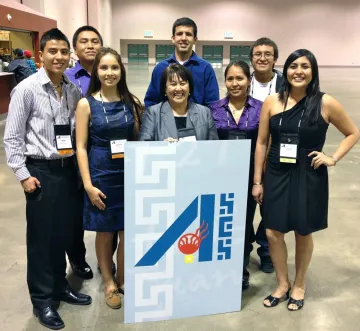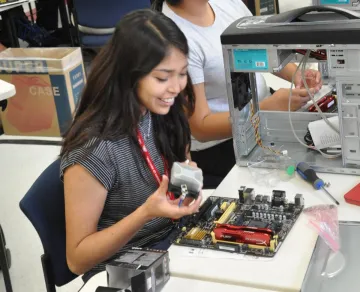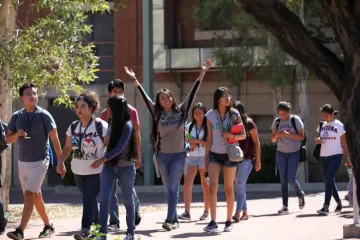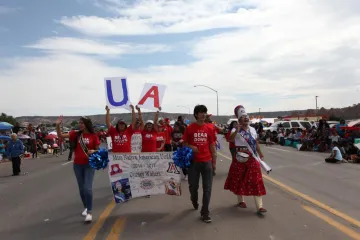History of NASEP
Origins of NASEP

The Indigenous Alliance served as a starting point for NASEP as an association of U.S. universities and colleges that are committed to providing college access to Native American/Alaskan Native students who are pursuing a post-secondary degree in Science, Technology, Engineering, or Mathematics (STEM). The Office of Early Academic Outreach has partnered with The University of Alaska-Anchorage in a National Science Foundation Partnership for Innovation Proposal titled Indigenous Alliance: Pre-College Component Expanding on Success. By participating in the Indigenous Alliance, Arizona joined nine other universities in an attempt to effect a systematic change in the hiring patterns on Indigenous Americans in STEM fields by increasing the number of individuals on the path to leadership in those areas.

The grant secured two years of NSF funding at $30,000 per year for The University of Arizona to operate NASEP. A grant from the Ak-Chin Casino secured by Karen Francis-Begay and the Center for Integrated Access Networks (CIAN) house out of the College Of Optical Sciences provides matching funds to support the local program. The NASEP project team has included representatives from the Office of Early Academic Outreach, the UA's President's Office, The College of Optical Sciences, Native American Student Affairs, Sunnyside Unified School District, Tucson Unified School District, other school Arizona districts, and current UA students.
The University of Alaska's Alaska Native Science and Engineering Program (ANSEP) led by Dr. Herb Schroeder builds on the Pre-College experience with additional components that guide indigenous students all the way through the educational pipeline to advanced degrees and careers in STEM fields. The momentum of that project has led to millions of dollars in federal funding for universities in Alaska and Hawaii to provide these services. By participating in Dr. Schroeder's Indigenous Alliance, The University of Arizona positions itself for additional federal funding opportunities that, with the support of Colleges on the UA campus, could lead to the development of a similarly effective pipeline program in the state of Arizona.
NASEP NOW

Since 2009, NASEP has had 180 students who have gone through 9 cohorts. We have had the pleasure of interacting with indigenous participants from Arizona, New Mexico, and Nevada that represent 22 different tribes, including: Aaniih, Acoma Pueblo, Cochiti, Gila River, Hopi, Jicarrila Apache, Lakota, Makah, Navajo, Northern Arapaho, Ogalala Sioux, Paiute, Pojoaque Pueblo, Salt River Pima, San Carlos Apache, Shoshone, Tohono O’odham, White Mountain Apache, Winnebago, Yaqui, Yurok, and Zuni.
The year-long program begins in June with a week-long stay at the University of Arizona located in Tucson, AZ. Participants attend workshops, complete interactive activities, and network with professionals in STEM. Staying in a dormitory on campus is beneficial to the student experience because participants get a glimpse of what it is like to live on campus during college. In addition, participants tour the university, are informed of our student resources, and learn about the college application process; this includes sessions on scholarships, financial aid, and admissions.
Communication between the student and NASEP continues after the participants return home, so that ongoing support is provided as they seeking scholarships and college admission. The cohort will reconvene throughout the year at academic or social events that aim to enhance their understanding of STEM fields, and bring the cohort together to have some fun. Thus far, the 2017 cohort has attended the Protecting Our Land Camp, walked in the Navajo Nation Parade as part of the University of Arizona, and have been a part of the Tribal Enviornmental Health Science Forum. These opporunities are shared throughout the year, and continue to enrich the academic and career goals of the students post residential stay at the college.

In addition, students also are part of the Geoscience Outreach Research Program, which allows our high school participants to conduct college-level research on areas of water-quality, food production, and weather and climate. This project happens in phases, with the last step consisting of participants presenting their research posters at the University of Arizona. It is truly a unique experience, that not only strengthen's the student's experience in STEM research, but also makes them stand out when applying for scholarships and colleges!
The program ends for each cohort around the end of April or beginning of May with a closing ceremony in which students and families socialize and are recognized over food and presentations. Despite it being the end of the cohort, NASEP alumni are encouraged to keep in contact with NASEP, as EAO continues to share opportunties with participants that will be helpful as the students enter college. Information on scholarships, internships, and employment are dispersed via the NASEP alumni listserve, Facebook group, and LinkedIn!
Program Enrichment
Partnership opportunities with other organizations within the UA and Tucson community have provided NASEP unique opportunities for program enrichment and depth of experience for its many participants.
- UA Green Fund
- AISES UA Chapter
- AISES Professional Chapter
- UA Native American Student Affairs
- RAIN
- IBM Native Network
- Geosciences
- CEAC
- Department of Hydrology
- Biosphere 2
- UA Alumni Association
- Dr. Marti Lindsey's office/dept.

